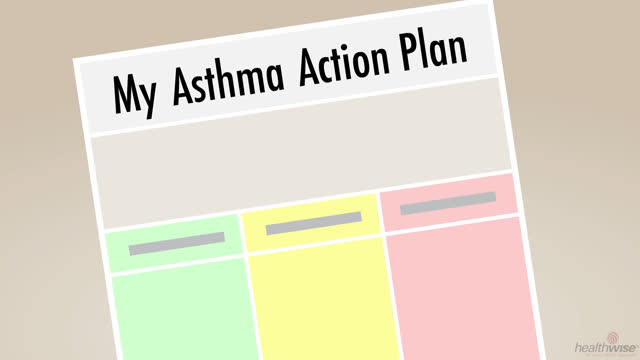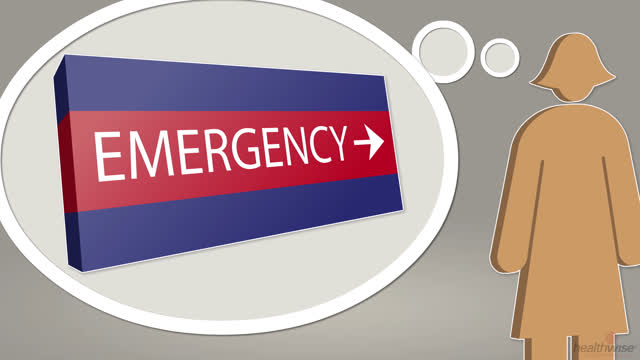Top of the pageActionset
Asthma: Taking Charge of Your Asthma
Introduction
During an asthma attack, the airways swell and narrow. This makes it hard to breathe. Although asthma is a lifelong disease, treatment can help control it and help you stay healthy.
You and your doctor will make an asthma action plan that outlines the two approaches to taking charge of asthma:
- Controlling asthma over the long term. Daily controller medicine helps reduce the swelling of your airways and prevent attacks.
- Treating attacks when they occur. The action plan will outline the steps to take and medicine to use to treat asthma attacks.
Using the asthma action plan also helps you keep track of your asthma and know how well your treatment is working.
If you or your child has been recently diagnosed, it may seem like there is a lot to remember. But the things you need to do to take charge of your asthma are really quite simple. With some practice, they will become part of your normal routine.
How to take charge of your asthma
Follow your asthma action plan
- Take your daily medicines as prescribed. This can keep asthma under control and help you avoid asthma attacks.
- Keep your treatment goals in mind. This may help you stay on your treatment.
- Review your list of triggers. Avoiding triggers can help reduce the chance that you will have an asthma attack.
Know your asthma zones
An action plan is based on zones that are defined by your symptoms, your peak flow, or both. There are three zones: green, yellow, and red. Your action plan tells you what to do when you are in each zone.
Check your symptoms or your peak flow, or both, on a regular basis, and use your action plan to see what zone you are in. If you have yellow zone symptoms or if your peak flow drops below 80% of your personal best measurement, follow your action plan. To figure out what 80% of your personal best measurement is, multiply your personal best measurement by 0.80. For example, if your personal best peak flow is 400, then 80% of that is 400 times 0.80, which is 320. To figure what 50% of your personal best peak flow is, multiply your personal best measurement by 0.50.
- Green means Go.
-
You are in the green zone if your peak flow is 80% to 100% of your personal best measurement.
This is where you want to be. Keep taking your daily asthma medicines as prescribed.
- Yellow means Caution.
-
You are in the yellow zone if your peak flow is 50% to 79% of your personal best measurement. You may not have any symptoms, but your lung function is reduced. When symptoms are present, you may cough, wheeze, or feel short of breath. Or your asthma may limit your activities or wake you up at night.
You should take action. Your action plan will tell you what medicines you need to take, how much to take, and when to take them. If you keep going into the yellow zone from the green zone, talk with your doctor. You may need a different medicine or the dose of your medicine may need to be increased.
- Red means DANGER.
-
You are in the red zone if your peak flow is less than 50% of your personal best measurement. You may be very short of breath. Or the quick-relief medicines may not have worked. This is dangerous.
Take the actions listed in your action plan and call your doctor. If you can’t get in touch with your doctor, go to the emergency department. Call 911 right away if you are having severe trouble breathing.
Use your asthma diary
- If you have an attack, write down what caused it (if you know), the symptoms, and what medicine you took.
- If you use a peak flow meter, write down your peak flow readings in your asthma diary( What is a PDF document? ).
Check your peak flow if your doctor recommends it
- Use your peak flow meter. This is a good way to check how well your lungs are working, which is called lung function. Your lung function can get worse without causing symptoms.
- Check your peak flow as often as your doctor tells you to. For many people this is twice a day, morning and evening.
- If you have trouble using your meter, talk with your doctor.
See your doctor to review your plan
Keep your regular follow-up appointments. During checkups, your doctor will ask if your symptoms or your peak flow, or both, have held steady, improved, or gotten worse. He or she will also ask if you have asthma symptoms during exercise or at night. This information can help your doctor know if your asthma category has changed or if you need to change medicines or doses.
When you go to your doctor:
- Take your asthma action plan and your asthma diary, if you have one. Get answers to any questions you may have about your asthma plans or your symptoms. Let your doctor know if treatment is not controlling your asthma symptoms.
- Take your peak flow meter and medicines so your doctor can review your treatment and the way you use the meter and medicines.
- Make sure you know how and when to call your doctor or go to the hospital.
- Tell your doctor if you are having trouble following your action plan.
Credits
Current as of: June 9, 2019
Author: Healthwise Staff
Medical Review:E. Gregory Thompson, MD – Internal Medicine & Adam Husney, MD – Family Medicine & Elizabeth T. Russo, MD – Internal Medicine
Current as of: June 9, 2019
Author: Healthwise Staff
Medical Review:E. Gregory Thompson, MD – Internal Medicine & Adam Husney, MD – Family Medicine & Elizabeth T. Russo, MD – Internal Medicine
This information does not replace the advice of a doctor. Healthwise, Incorporated, disclaims any warranty or liability for your use of this information. Your use of this information means that you agree to the Terms of Use. Learn how we develop our content.





